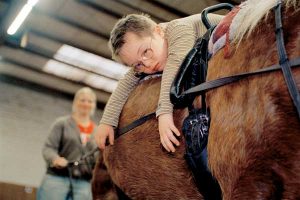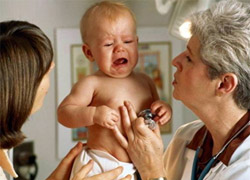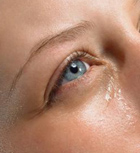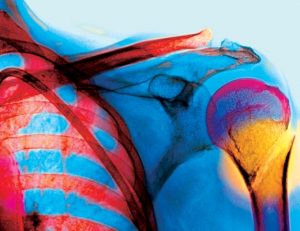Purpose: horse
 Hippocrates argued that horse riding speeds up not only the recovery process after injuries, but also helps melancholics no less effectively, freeing them from “dark thoughts”, instilling “merry and clear thoughts”. Unfortunately, this direction in medicine for a long time did not attach importance. And only in the middle of the 20th century, in the wake of a resurgent interest in “folk healing”, they remembered about zootherapy, which was called “pet therapy” or “animal therapy”. And although the scientific explanation of the healing effect is a matter of the future, practical results are impressive today.
Hippocrates argued that horse riding speeds up not only the recovery process after injuries, but also helps melancholics no less effectively, freeing them from “dark thoughts”, instilling “merry and clear thoughts”. Unfortunately, this direction in medicine for a long time did not attach importance. And only in the middle of the 20th century, in the wake of a resurgent interest in “folk healing”, they remembered about zootherapy, which was called “pet therapy” or “animal therapy”. And although the scientific explanation of the healing effect is a matter of the future, practical results are impressive today.
As a resident of St. Petersburg, I heard about the St. Petersburg Center of Centaurek in Moscow at the IV Hippotherapy Conference in December 2005 in Moscow. And upon returning home, I arranged a meeting with Olga Nikolaevna Berchin, the general director of Kentavrica, and Maria Ivanovna Lipkina, an instructor and specialist in hippotherapy, met and remained here as a volunteer. And therefore, in particular, I know firsthand about the possibilities of zootherapy and hippotherapy, although it is probably more important what patients themselves think about this. This is what one of the regular students of the center wrote:
“My name is Kira. I’m 34, I suffer from cerebral palsy. Although now I do not suffer, I live! My disease has a form that does not affect the intellect, it limits motor capabilities. And I suffered not so much physically, rather psychologically. To cope with this problem alone is impossible. Looking for helpers. But where to find them? I even stopped visiting doctors who told me how bad everything was with me: “How do you work as a typist, you have such weak hands!” If that were said to me now, I would just smile and answer: “Let’s go and race with you ! ”
I met real allies here. They never mentioned that I could not do something or that a disease with such experience and such a diagnosis is incurable. Every year I heard this opinion more and more often from the multitude of doctors I encountered. Hmmm … Incurable, speak? We’ll see!”
There would be no happiness, but misfortune helped
The impetus to the development of hippotherapy – therapeutic riding – was the story of the Danish cavalry athlete Liz Hartel. After suffering polio, she was partially paralyzed, and it would seem that a sports career could be forgotten forever. But one day, when Liz was brought in a wheelchair to the racetrack, she still tried to get on the horse again and even get a little ride on it. A week later, the girl reappeared at the stable, and then again and again … and for so long 9 years. The result exceeded all expectations, despite the fact that the most optimistic forecasts of doctors sounded like this: he can walk, but only with the help of two reeds. In 1952, at the Olympic Games in Helsinki, Liz Hartel won a silver dressage medal. Liz immediately came to the attention of journalists, doctors and, of course, thousands of sick people. After that, first in Europe, then in the USA, hippotherapy centers were established. In 1975, speaking at the conference of the Association of Riding, Liz will say: “I am sure that horse riding lessons are useful for most people who suffer not only from polio, but also from almost all other physical illnesses.”
In our country, the first groups of therapeutic riding appeared in the early 90s – with a lag of half a century. Perhaps, the experts were waiting for their foreign colleagues to bring the same scientific platform for a new method? And although it still does not exist, the results are obvious. And it gives every reason to develop zootherapy as an aid for the rehabilitation and treatment of people with disabilities in Russia.
Live sports equipment
The mechanism of the effect of hippotherapy on the human body is based on the principles of physiotherapy exercises with the participation of a live “simulator”, by means of which all muscle groups of the body are subjected to stress. Active training occurs at the reflex level, that is, moving along with the horse, a person instinctively tries to keep balance so as not to fall, and thus makes both healthy and affected muscles work without noticing it. This is especially valuable in diseases complicated by problems of the musculoskeletal system, scoliosis, osteochondrosis. I must say that horseback riding is an ideal way to lose weight. Massage of the horseman’s warmed muscles with a warm horse helps to normalize blood circulation, increase muscle tone and reduce body fat. Today, many people in this way shed those extra pounds!
In the treatment of neurosis, infantile cerebral paralysis, mental retardation, autism, the main factor in the treatment process is psychogenic. Strong, graceful animals have a powerful emotional impact on people. The mere fact that a child can move without the support of adults and control the animal himself is a strong anti-depressant. In addition, the rhythmic movements of the horse in a step contribute to the restoration of the biological rhythms of the rider.





